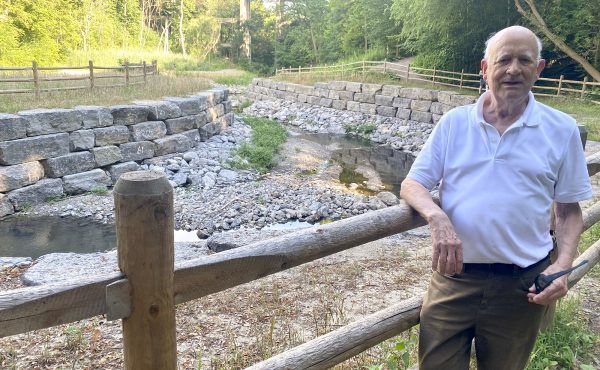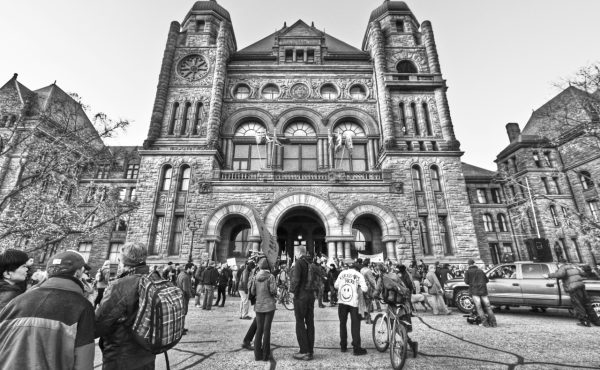

Cross-posted to Spacing Votes
An immodest proposal for the Gardiner
The depressing thing about this election is that the voters are being told they’re not allowed to talk about city building. Setting aside Jane Pitfield’s hell-in-a-handcart rhetoric and the methane emanating from the $300,000-man Stephen LeDrew, David Miller has said we can’t debate highway tolls, congestion charges and the future of the Gardiner. Everyone’s forgotten about Union Station. Miller’s taking credit for a waterfront planning process that chugs along on its own steam. As for the island airport, the mayor will produce sound-bite outrage, but we all know that debate’s done and gone.
Rather than accepting a controversy-free election, I’d like to challenge the candidates to sink their teeth into one of the Gardiner proposals that gets no love from the Toronto Waterfront Revitalization Corporation nor ink from the media, yet represents a genuinely gutsy and immodest proposal with the potential to transform all those new lakefront development tracts into truly urban communities.
The so-called “Transformation” option, at its most basic, involves shifting Lakeshore Boulevard out from beneath the Gardiner and then eliminating several of the space-hogging on/off ramps. The insight at the heart of this plan, developed in 2002 by architects John van Nostrand and Calvin Brooks, is that barrier effect along the waterfront is due to the fact that the two roads are stacked, and thus form a kind of vehicular Berlin Wall. Under the plan — which, at an estimated $415 million, is the cheapest of the three Gardiner options — Lakeshore is turned into a normal six-lane road with no ceiling. But the cool part of this plan is that it frees up acres of publicly-owned space beneath the Gardiner, which can be put to new and interesting uses. This is infill at its grittiest.

Skeptical? Miller is, as are the waterfront planners. But they’d do well to check out what’s happened beneath the Westway, an elevated expressway that presses through the heart of north-west London. Since the 1980s, a not-for-profit trust has methodically reclaimed 23 acres of land under that expressway, establishing an amazing array of local amenities [photos above], including a skate park [photo below], a soccer pitch [photo top], a child care, complexes for offices and shops [photo below], as well as a range of other structures, such as artists studios and light industrial buildings. The trust is run by a coalition of north-end London organizations, and thus responds to the needs of a dense, diverse community. This is a terrific example of how city building initiatives can percolate up, rather than being imposed from on high by land-use planning exercises driven by developers, architects and engineers.
But let’s not forget about the money. Miller and Pitfield insist there’s no money for the Gardiner tear-down. Maybe they should consider this detail: the Westway Trust has generated some 300 million pounds of development over the years, a windfall that strongly suggests the City of Toronto could make the Transformation option pay for itself. No tolls. No casinos. No parking surtax. Rather, it’s about letting the city grow organically into all the nooks and crannies developers scoff at, but frequently turn out to be the most compelling urban spaces.
The TWRC’s humongous Gardiner study, released last week, said the Transformation option requires “significant” repair work on the Gardiner decks to make sure they don’t collapse on the buildings or parks proposed for their nether regions. But the TWRC’s cost estimates didn’t include the $12 million a year the city currently shells out for ongoing structural maintenance on the Gardiner, nor the projected revenues from re-developing all that freed-up land.
Toronto used to be really good at this sort of thing — reclaiming orphaned spaces and eschewing the big-buck mega-project for a more nuanced reading of how cities work. In other words, the Transformation option is perfectly calibrated to Toronto’s fiscally cautious but urban-minded political temperament. It won’t clog the roads or break the bank. Yet it will allow the East Bayfront to evolve into a real neighbourhood, with all the little odd-ball amenities diverse urban neighbourhoods need, but developers tend not to build.
As I’ve written previously, the TWRC’s preferred option — tearing down the Gardiner from Spadina to the Don River and replacing it with a grand street — deserves serious consideration. But the Transformation option is a realistic alternative, one that offers up an urban-minded, pedestrian-scale solution at an affordable price. And it seems to me that an election is the ideal time to begin having a discussion about the relative merits of each.





